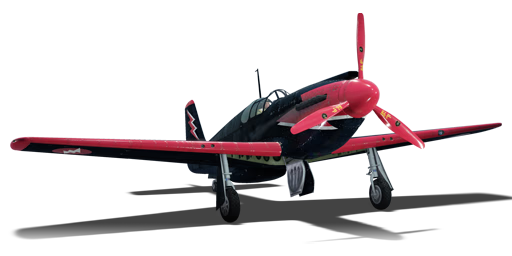


The P-51A was one of the first variants of the P-51. It is quite similar to the A-36, which is essentially a ground-attack-focused P-51. One of the main improvements of the P-51A over previous Mustangs is the uprated engine. The Allison V-1710-81 inline 12-cylinder engine could produce up to 1,200 hp and could sustain much of that at higher altitudes thanks to its supercharger. It was also fitted with a bigger propeller, which further increased performance. The P-51A would be one of the fastest fighters at the time, thanks to its unique design and powerful engine. In addition to its excellent performance, the P-51A was armed with four 12.7 mm machine guns in the wings. However, due to the thin wings and cramped nature, the machine guns had frequent jams. A significant number of P-51As were sent to the Royal Air Force and served for much of the war. Over 1,500 P-51As were produced until the superior Merlin engine became available for the Mustang.
Introduced during Update 1.55 "Royal Armour" as a reward vehicle for the 2015 Thunder League event, the P-51A is an extremely rare aircraft. Since it is an early Mustang, it still features the Allison V-1710 engine. However, it had one of the best Allison engines before the switch to the Merlin engine, thanks to the addition of a supercharger. Combined with its relatively low battle rating, the P-51A is an excellent fighter. It excels with boom and zoom tactics thanks to its impressive dive performance, but players must note its compressibility. At lower altitudes, players need to be careful when performing aggressive dives. In addition, it's important to not engage in dogfights unless the enemy aircraft is at a major disadvantage or it is absolutely necessary.
flaps
flaps
flaps
brake
| Belt | Belt filling | Armor penetration (mm) at a distance: | |||||
|---|---|---|---|---|---|---|---|
| 10 m | 100 m | 500 m | 1000 m | 1500 m | 2000 m | ||
| T/Ball/Ball/I/AP-I | 28 | 26 | 18 | 11 | 7 | 4 | |
| AP-I/AP-I/AP-I/T/I | 28 | 26 | 18 | 11 | 7 | 4 | |
| T/AP/AP/AP/AP-I/I | 30 | 27 | 20 | 13 | 9 | 6 | |
| T/T/T/T/T/AP-I | 28 | 26 | 18 | 11 | 7 | 4 | |
| AP/AP-I/AP-I/I/I | 30 | 27 | 20 | 13 | 9 | 6 | |







 2 x (50 / 100 / 200) %
2 x (50 / 100 / 200) % 
 2 x 124 %
2 x 124 % 

Flight performance | |
|---|---|
Weaponry |
|---|